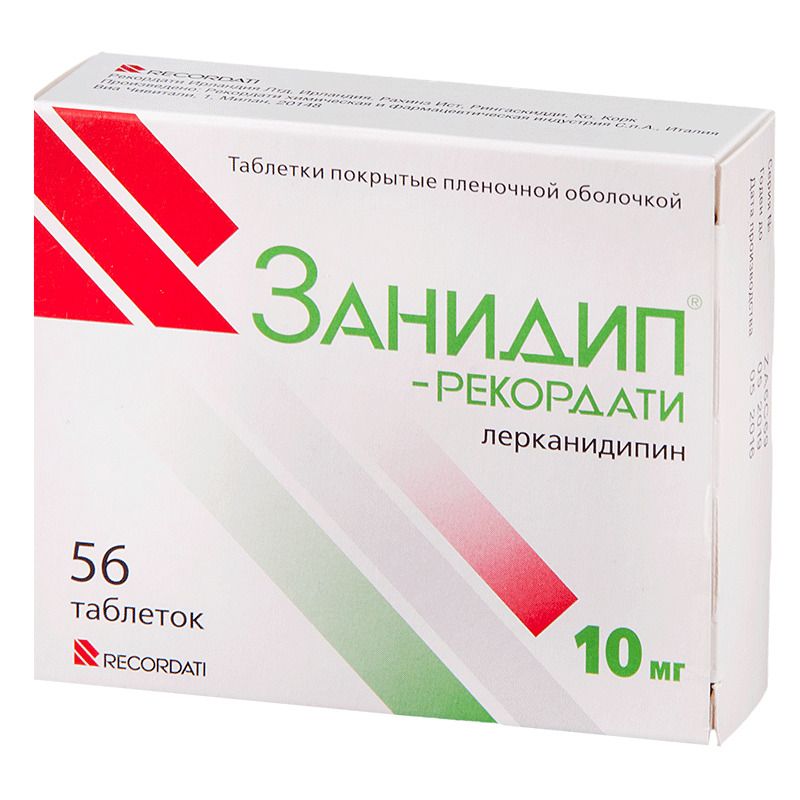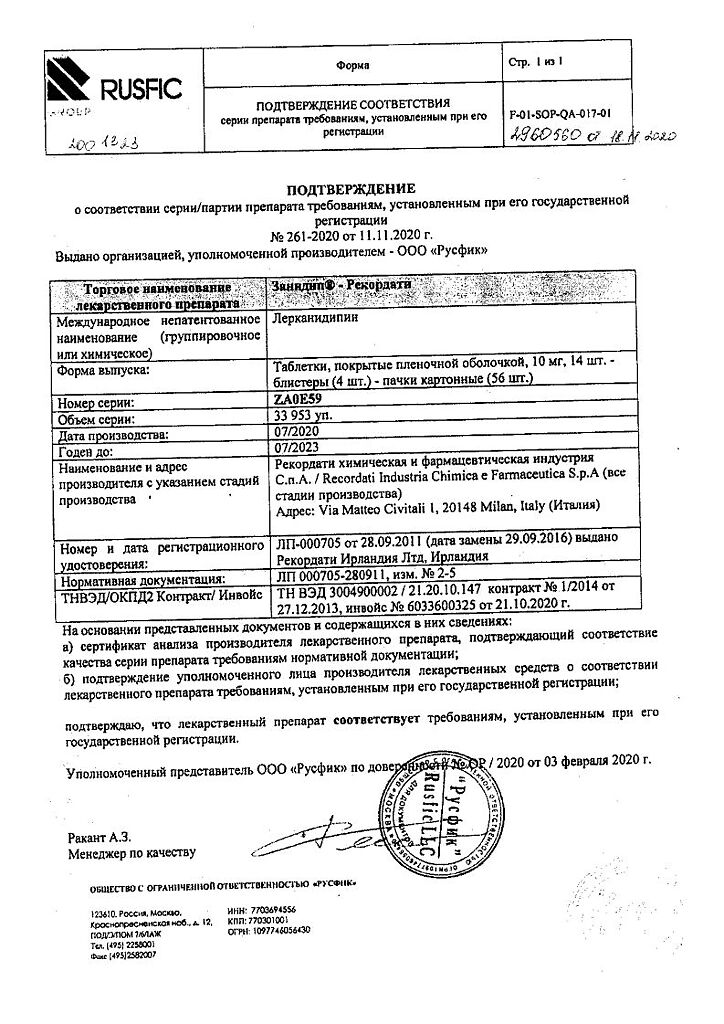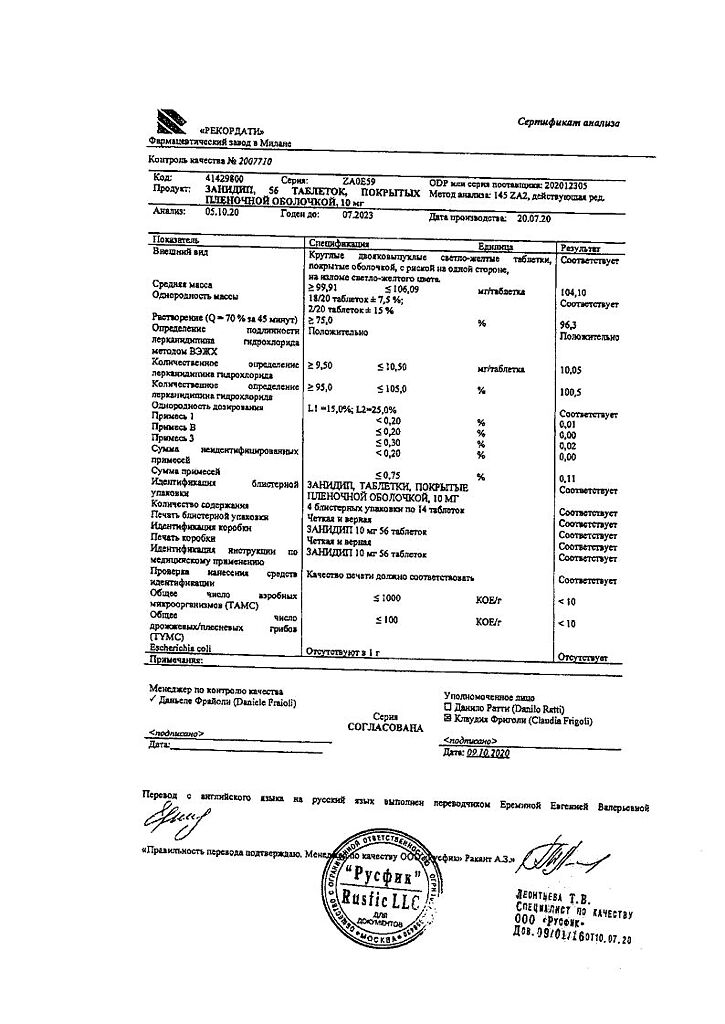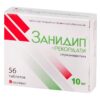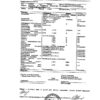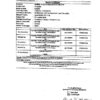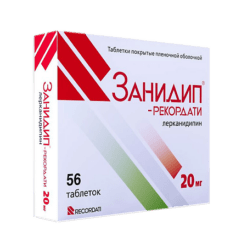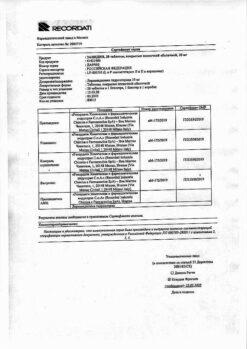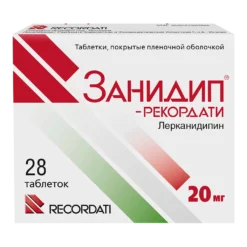No products in the cart.
Zanidip-Recordati, 10 mg 56 pcs
€21.10 €17.59
Description
A “slow” calcium channel blocker. Lercanidipine is a racemic mixture of right- (R) and left-rotating (S) stereoisomers, a 1,4-dihydropyridine derivative capable of selectively blocking the flow of calcium ions inside vascular wall cells, cardiac cells and smooth muscle cells.
Indications
Indications
Zanidip-Recordati is prescribed for the treatment of essential hypertension of mild to moderate severity.
Pharmacological effect
Pharmacological effect
Blocker of “slow” calcium channels. Lercanidipine is a racemic mixture of dextro- (R) and levorotatory (S) stereoisomers, a derivative of 1,4-dihydropyridine, capable of selectively blocking the flow of calcium ions into the cells of the vascular wall, cardiac cells and smooth muscle cells.
Special instructions
Special instructions
Caution should be exercised when prescribing to patients with impaired renal function or coronary artery disease (there is a risk of increased frequency of angina attacks).
Before starting to use the drug, it is necessary to compensate for chronic heart failure.
Particular caution should be observed in the initial stages of treatment in patients with mild to moderate liver failure.
Impact on the ability to drive vehicles and operate machinery
During the treatment period, care must be taken when performing work that requires increased attention, when driving, especially at the beginning of treatment and when increasing the dose of the drug (risk of drowsiness, headache and dizziness).
Active ingredient
Active ingredient
Lercanidipine
Composition
Composition
1 tablet:
Pregnancy
Pregnancy
The drug is contraindicated for use during pregnancy and lactation.
Contraindications
Contraindications
— chronic heart failure in the stage of decompensation;
– unstable angina;
– obstruction of blood vessels originating from the left ventricle of the heart;
— recent myocardial infarction (within 1 month);
– severe liver dysfunction;
– impaired renal function (glomerular filtration rate less than 39 ml/min);
– simultaneous use with powerful inhibitors of the CYP3A4 isoenzyme (ketoconazole, itraconazole, erythromycin), as well as with grapefruit juice, cyclosporine;
– lactase deficiency, lactose intolerance, glucose/galactose malabsorption syndrome;
– children and adolescents under 18 years of age (efficacy and safety have not been established);
– pregnancy;
– lactation period;
– women of childbearing age who do not use reliable contraception;
– hypersensitivity to lercanidipine, other dihydropyridine derivatives or any component of the drug.
With caution: mild to moderate liver dysfunction; sick sinus syndrome (without pacemaker); left ventricular failure and ischemic heart disease; chronic heart failure; simultaneous use of beta-blockers, digoxin.
Side Effects
Side Effects
The incidence of adverse events was classified as follows: very common (1/10), common (1/100), uncommon (1/1000), rare (1/10,000), very rare (<1/10,000).
From the nervous system: rarely – drowsiness; infrequently – headache, dizziness.
From the immune system: very rarely – hypersensitivity.
From the cardiovascular system: infrequently – tachycardia, palpitations, flushes of blood to the skin of the face; rarely – angina pectoris; very rarely – fainting, marked decrease in blood pressure, chest pain, myocardial infarction.
From the digestive system: rarely – nausea, vomiting, diarrhea, abdominal pain, dyspepsia; very rarely – a reversible increase in the activity of liver enzymes.
From the skin: rarely – skin rash.
From the musculoskeletal system: rarely – myalgia.
From the urinary system: rarely – polyuria.
Other: infrequently – peripheral edema; rarely – asthenia, increased fatigue; very rarely – gum hyperplasia.
Interaction
Interaction
The drug should not be taken simultaneously with inhibitors of CYP3A4 (liver cytochrome P450 isoenzyme), such as ketoconazole, itraconazole, erythromycin (increase the concentration of lercanidipine in the blood and lead to potentiation of the antihypertensive effect).
Concomitant use of lercanidipine with cyclosporine is contraindicated, because this leads to an increase in the content of both substances in the blood plasma.
Lercanidipine should not be taken with grapefruit juice, as this leads to inhibition of lercanidipine metabolism and potentiation of the antihypertensive effect.
Caution must be exercised when taken concomitantly with drugs such as terfenadine, astemizole, quinidine and class III antiarrhythmic drugs (for example, amiodarone).
Concomitant use with anticonvulsants (for example, phenytoin, carbamazepine) and rifamycin may lead to a decrease in the plasma level of lercanidipine and, therefore, a decrease in the antihypertensive effect of lercanidipine.
When taking digoxin concomitantly, it is necessary to regularly monitor for signs of digoxin intoxication.
Taking the drug with midazolam in old age leads to an increase in the absorption of lercanidipine and a decrease in the rate of absorption.
Metoprolol reduces the bioavailability of lercanidipine by 50%, while the bioavailability of metoprolol remains unchanged. This effect may occur due to a decrease in hepatic blood flow, which is caused by beta-blockers, and may therefore also occur when used with other drugs in this group.
Cimetidine at a dose of 800 mg/day does not lead to significant changes in the concentration of lercanidipine in the blood plasma, however, special caution is required, because At higher doses of cimetidine, the bioavailability of lercanidipine, and therefore its antihypertensive effect, may increase.
When used simultaneously with simvastatin, the drug should be taken in the morning, and simvastatin in the evening.
Fluoxetine has no effect on the pharmacokinetics of lercanidipine.
Taking lercanidipine simultaneously with warfarin does not affect the pharmacokinetics of the latter.
Lercanidipine can be used simultaneously with beta-blockers, diuretics, and ACE inhibitors.
Ethanol may enhance the antihypertensive effect of lecarnidipine.
Overdose
Overdose
Symptoms: peripheral vasodilation with a pronounced decrease in blood pressure and reflex tachycardia, increased frequency and duration of angina attacks, myocardial infarction.
Treatment: carry out symptomatic therapy.
Storage conditions
Storage conditions
The drug should be stored out of the reach of children at a temperature not exceeding 30°C.
Shelf life
Shelf life
3 years.
Manufacturer
Manufacturer
Recordati chemical and pharmaceutical industry, Italy
Additional information
| Shelf life | 3 years. |
|---|---|
| Conditions of storage | The drug should be kept out of reach of children at a temperature not exceeding 30 ° C. |
| Manufacturer | Recordati chemical and pharmaceutical industry, Italy |
| Medication form | pills |
| Brand | Recordati chemical and pharmaceutical industry |
Other forms…
Related products
Buy Zanidip-Recordati, 10 mg 56 pcs with delivery to USA, UK, Europe and over 120 other countries.

